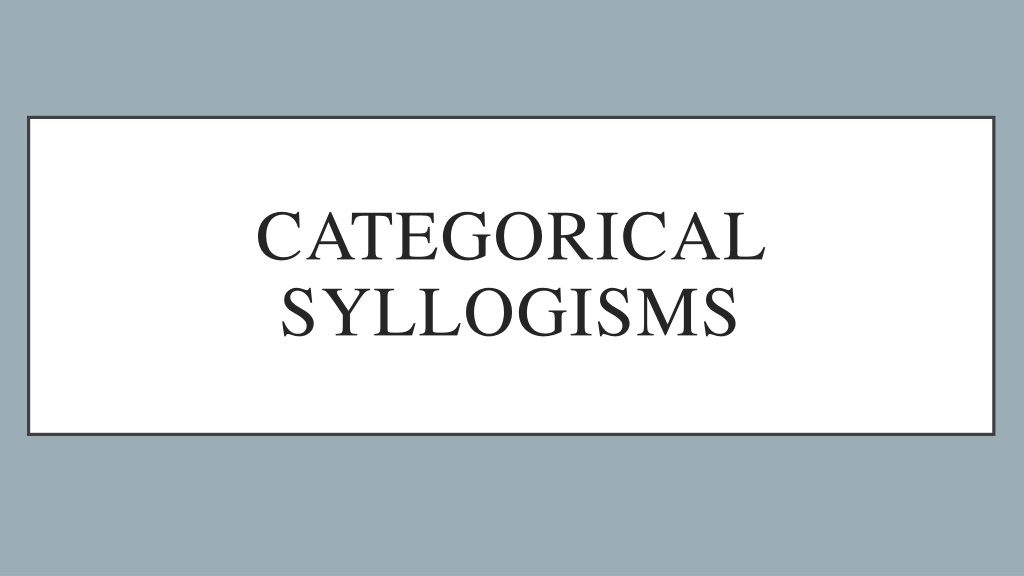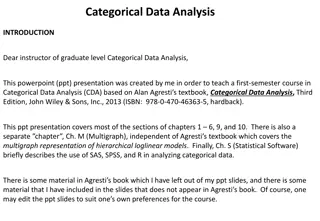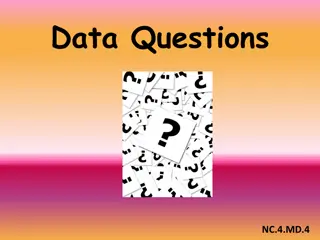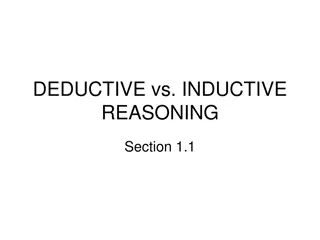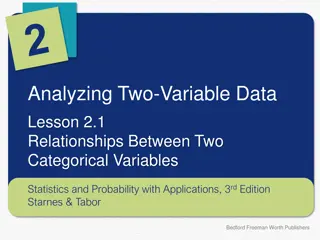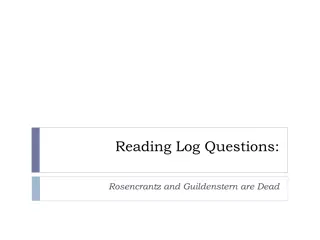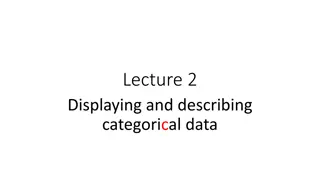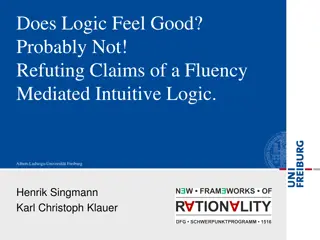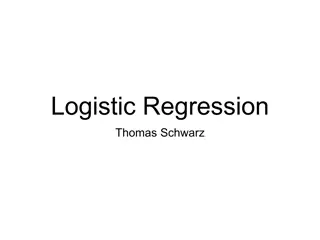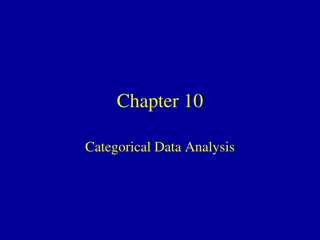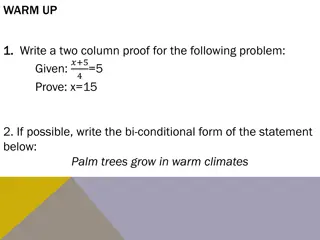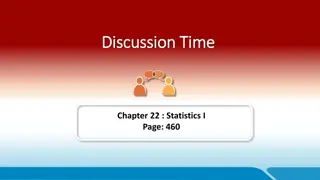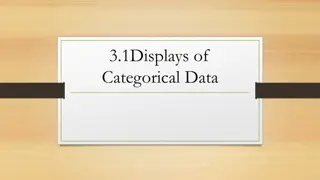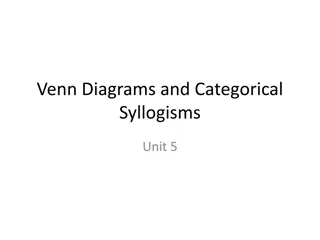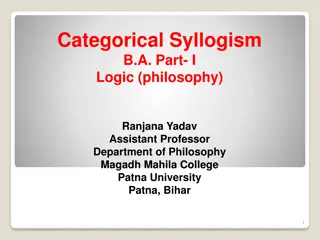Categorical Syllogisms: Types and Examples
A categorical syllogism is a deductive argument based on the relations of classes (categories) where a conclusion is drawn from two premises involving three terms. In standard form, the premises and conclusion are in categorical form (A, E, I, O), each term occurs twice, and the middle term does not appear in the conclusion. The terms of syllogisms - minor, major, and middle - play specific roles in identifying the conclusion. The mood of a syllogism is determined by the types of categorical propositions it contains, represented by a sequence of letters. Explore the structure and components of categorical syllogisms through examples and explanations.
Download Presentation

Please find below an Image/Link to download the presentation.
The content on the website is provided AS IS for your information and personal use only. It may not be sold, licensed, or shared on other websites without obtaining consent from the author.If you encounter any issues during the download, it is possible that the publisher has removed the file from their server.
You are allowed to download the files provided on this website for personal or commercial use, subject to the condition that they are used lawfully. All files are the property of their respective owners.
The content on the website is provided AS IS for your information and personal use only. It may not be sold, licensed, or shared on other websites without obtaining consent from the author.
E N D
Presentation Transcript
CATEGORICAL SYLLOGISMS
A categorical Syllogism is a deductive argument in which a conclusion is inferred from two premises. These are argument based on the relations of classes (categories). Categorical syllogisms are deductive arguments consisting of three categorical propositions, which contain 3 terms. Each of these 3 terms occurs exactly twice.
1 1 1. No bananas are animals. 1 2 2. Some mammals are animals. 2 2 3. Therefore, some mammals are not bananas. Term 1: Bananas Term 2: Animals Term 3: Mammals
STANDARD-FORM CATEGORICAL SYLLOGISM A syllogism is in standard form when: 1. Its premises and its conclusion are in categorical form: A, E, I, O. 2. There are exactly 3 different terms. 3. Each term occurs twice. 4. The major premise is always stated first, the minor second, and the conclusion last. 5. The middle term NEVER occurs in the conclusion.
TERMS OF SYLLOGISMS: MINOR, MAJOR, MIDDLE To identify the terms by name we look at the conclusion: 1. No trees are humans. 2. Some babies are humans. 3. Therefore, some babies are not trees.
The conclusion: Some babies are not trees. Subject: babies Predicate: trees. The predicate of the conclusion is the Major term. The subject of the conclusion is the Minor term. The term that does not occur in the conclusion humans is the Middle term.
The premise containing the major term, is the major premise. The premise containing the minor term, is the minor premise.
THE MOOD OF THE SYLLOGISM
The Mood of a syllogism is determined by the types of categorical propositions it contains. The mood is represented by 3 letters: First letter names major premise; second letter names the minor premise; the third names the conclusion.
1. No trees are humans. = E 2. Some babies are humans. = I 3. Therefore, some babies are not trees. = O The mood of this syllogism is EIO.
THE FIGURE OF THE SYLLOGISM
To precisely characterize the logical form of a syllogism, we need to know more. We need to know the Figure Let s see why: Compare 2 syllogisms, A and B, which have the same mood AII: (A) 1. All scientists are college graduates. 1. All artists are egoists. 2. Some athletes are college graduates. 3. So, some athletes are scientists. (B) 3. So, some Americans are egoists. 2. Some artists are Americans.
Notice that both syllogisms have the same form AII, but (A) is invalid and (B) is valid. Let s see what makes one valid and the other invalid. Let s assign the letter S for the minor term the subject of the conclusion the letter P for the major term the predicate of the conclusion and the letter M for the middle term: (A) 1. All scientists are college graduates. 2. Some athletes are college graduates. 3. Therefore, some athletes are scientists. = Some S are P = All P are M = Some S are M Notice: The middle term is the predicate term of both the major and minor premises.
Again, lets assign the letter S for the minor termthe subject of the conclusionthe letter P for the major term the predicate of the conclusion and the letter M for the middle term: (B) 1. All artists are egoists. 2. Some artists are Americans. 3. So, some Americans are egoists. = Some S are P = All M are P = Some M are S Notice: The middle term is the subject term of both the major and minor premises.
(A) All P are M Some S are M Some S are P (B) All M are P Some M are S Some S are P To precisely describe the form of a categorical syllogism, we must state its mood and its figure. The figure is determined by the position of the middle term in the premises. And depending on the position of the middle term in the premises, a syllogism can be valid or invalid.
SYLLOGISMS HAVE ONLY 4 POSSIBLE FIGURES
FIGURE 1 The middle term is the subject of the major premise and the predicate of the minor premise. M P S M S P
FIGURE 2 The Middle term is the predicate of both the major and minor premises. P M S M S P
FIGURE 3 The middle term is the subject of both the major and the minor premises. M P M S S P
FIGURE 4 The Middle term is the predicate of the major premise and the subject of the minor premise. P M M S S P
A TRICK TO REMEMBER A way to remember the 4 figures is by looking at the 4 figures horizontally: 1 M P S M S P 2 3 M P M S S P 4 P M M S S P P M S M S P Notice the pattern of the Middle term forming a W shape:
2 4 P M S M S P M P S M S P M P M S S P P M M S S P 1 3
Any standard-form categorical syllogism is completely described when we specify its mood and figure. 1. No bananas are animals. = E 2. Some mammals are animals. = I 3. Therefore, some mammals are not bananas. = O The mood of this syllogism is EIO. And its figure is 2. Its complete description is EIO-2.
If we list all categorical syllogisms by mood beginning with AAA, AAE, AAI, AAO all the way to OOO we would have enumerated 64 moods. And since each mood can occur in each of the 4 figures, 64 x 4 = 256.
EXERCISES Rewrite each of the following syllogisms in standard form, and name its mood and figure. Procedure: Identify the conclusion. Identify its predicate term and its subject term. Its predicate is the major term. Its subject is the minor term. Identify the major premise (the one with the major term) Rewrite the argument in standard form. Name the mood and the figure.
1. No nuclear-powered submarines are commercial vessels. So no warships are commercial vessels. Because all nuclear-powered submarines are warships. 2. Some evergreens are objects of worship, because all fir trees are evergreens, and some objects of worship are fir trees. 3. All artificial satellites are important scientific achievements; therefore, some important scientific achievements are not US inventions, inasmuch as some artificial satellites are not US inventions.
4. No television stars are certified public accountants, but all certified public accountants are people of good business sense; it follows that no television stars are people of good business sense. 5. Some conservatives are not advocates of high tariff rates, because all advocates of high tariff rates are Republicans, and some Republicans are not conservatives. 6. All proteins are organic compounds, hence all enzymes are proteins, as all enzymes are organic compounds.
